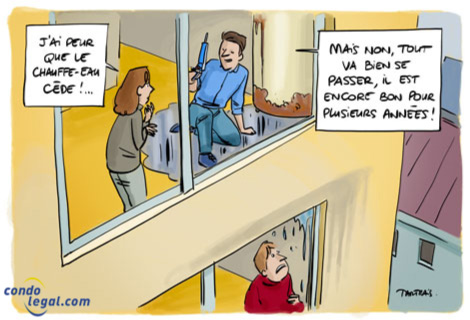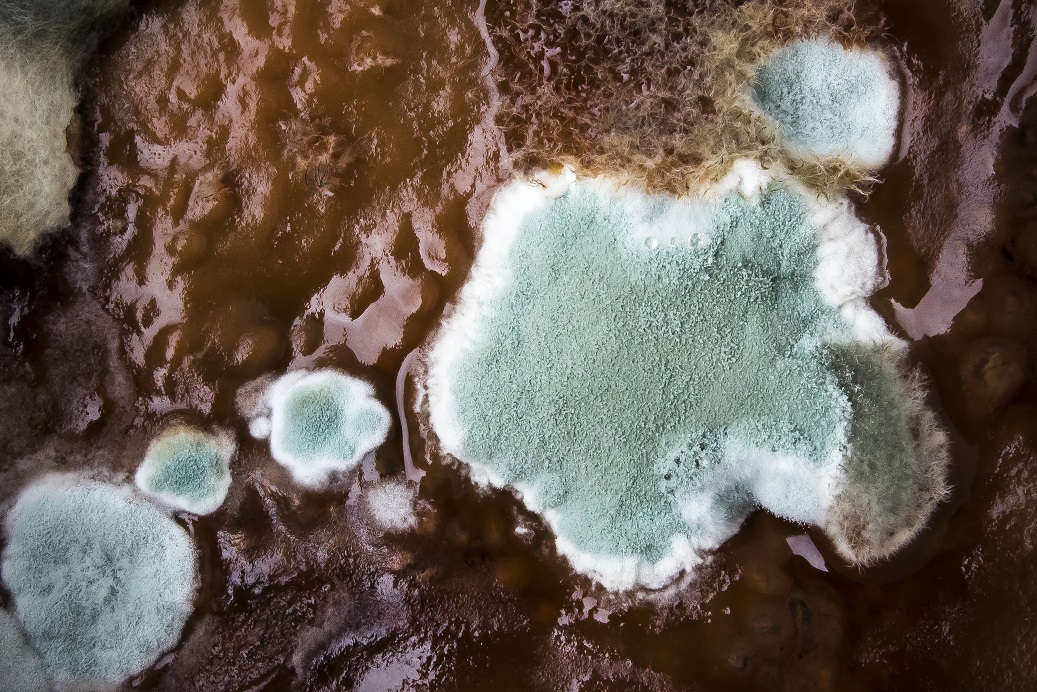Date published: 07/03/2024
Prevention of a water damage
 The occurrence of a loss in a co-ownership (condominium) is never good news; a significant water damage is likely to cause lasting damages within the immovable. Considering the impact of water damage on a co-ownership's budget, preventive measures must be implemented to monitor components and equipment at higher risk. Moreover, effective and regular communication between the board of directors and the co-owners is essential to raise awareness of the importance of keeping their private portions in good condition and immediately reporting any anomaly that could lead to water damages.
The occurrence of a loss in a co-ownership (condominium) is never good news; a significant water damage is likely to cause lasting damages within the immovable. Considering the impact of water damage on a co-ownership's budget, preventive measures must be implemented to monitor components and equipment at higher risk. Moreover, effective and regular communication between the board of directors and the co-owners is essential to raise awareness of the importance of keeping their private portions in good condition and immediately reporting any anomaly that could lead to water damages.
Prevention of losses
Prevention refers to all measures established on a permanent basis to eliminate risks, reduce the probability of occurrence of hazards and mitigate their potential effects.
Prevention of losses in the the common portions
The maintenance of the common portions is under the responsibility of the syndicate of co-owners; it's important to know that in principle, the envelope of the building, that is to say the roof, the walls as well as the piping and wiring are common portions. For example, regular maintenance of the water mains and of the sewers as well as that of the water proofing elements of the roofs and terraces is in the best interest of the co-ownership as it will prevent leaks.
Furthermore, pipes that run close to the outside air must be protected to avoid the risk of ice plugs forming in the winter; also, in autumn, outdoor taps should be drained to prevent potential pipe breakage caused by freezing.
Prevention of losses in the private portions
In a private portion, it is possible to reduce water losses with a few regular checkups. First, during a moving in of a co-owner, it is necessary to identify the different water supply taps to ensure that they are all in good condition and accessible in case of problems; this will allow to reduce the damages caused by water. Then, the co-owners must adopt exemplary conduct by:
- ensuring that the access to the water inlet valve is clear of obstructions so that the water supply can be quickly shut off in the event of an emergency;
- inspecting their water heater from time to time and so, in order to detect any possible water leaks in the holding tank or on the floor to replace it before the end of its useful life;
- closing windows when they're away when the weather and temperature conditions are uncertain and so, to prevent infiltration in the event of rain;
- avoiding to use a washing machine or a dishwasher when nobody is present and so, even for a short period of time;
- closing the water inlets in the case of a long absence;
- verifying on a regular basis if the windows are watertight;
- monitoring the condition of seals around sanitary fittings to ensure watertightness;
- keeping a regular lookout on their ducts and faucets to intervene quickly in the event of a leak;
- maintaining the water supply systems including the shut-off valves;
- checking the connections of their washing machines, their refrigerators with ice-makers as well as their dishwashers;
- installing a water leak detection system and an alarm to shut down the water inlets in the case of problems;
- having the joints (seals) of the shower, the bathtub, the sinks and the tiles redone as often as necessary;
- checking regularly the condition of the faucets and the water pipes, these having to be kept dry;
- replacing washer and dishwasher supply and drain hoses every 5 years when made of rubber and every 10 years when made of braided steel;
- replacing the plastic nut on the flexible toilet supply pipe when it turns yellow;
- maintaining a minimum amount of heating and so, especially during winter;
- being vigilant when work is being carried out in their private portion, that is to say not to leave the room as long as it's not sufficiently protected.
Declaration of co-ownership: risk management tool
Declarations of co-ownership can also be an effective way of encouraging co-owners to manage the risks associated with water damages; thus, they can stipulate that co-owners, lessees (tenants) and other occupants who are absent for a certain period of time, this period varying from one declaration of co-ownership to another, must shut off the supply valve of their residential dwelling unit. Also, the by-laws of the immovable, second section of the declaration of co-ownership, may contain strict guidelines, limitations and even prohibitions concerning work that may be carried out in a private portion; for instance, it may be stipulated that all plumbing work must be submitted to the board of directors for approval before everything can begin.
Register of water heaters
To prevent a water damage, every syndicate of co-owners should keep a computerized register showing the date of installation of the water heaters and their age; this register should be interactive so that an alert can be sent to members of the board of directors or to the condo manager enabling action to be taken when a water heater reaches the end of its useful life.
 WHAT YOU SHOULD KNOW! Insurance never covers the causes of a loss; it only compensates its consequences.
WHAT YOU SHOULD KNOW! Insurance never covers the causes of a loss; it only compensates its consequences.
 WHAT TO KEEP IN MIND: More and more co-ownerships in Quebec are opting for the installation of water leak detection systems; not to say essential, this practice has become necessary since several losses have had a negative impact on insurance premiums and deductibles.
WHAT TO KEEP IN MIND: More and more co-ownerships in Quebec are opting for the installation of water leak detection systems; not to say essential, this practice has become necessary since several losses have had a negative impact on insurance premiums and deductibles.
 WARNING! To avoid a water damage, water heaters must be at the top of the list of devices to be placed under high surveillance; these devices must be replaced no later than every 10 years because if not, the risk of leaks will increase significantly.
WARNING! To avoid a water damage, water heaters must be at the top of the list of devices to be placed under high surveillance; these devices must be replaced no later than every 10 years because if not, the risk of leaks will increase significantly.
Back to the factsheet: Water damages





